After performing over 7000 dermal chelations, hundreds on the same clients for over a decade, we began to notice similar patterns to the client’s recovery process. Keeping meticulous records has allowed us to identify five distinct phases for dermal chelation.
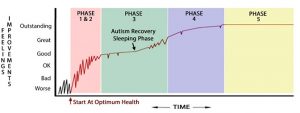
Dermal Chelation: Phase 1
Phase 1 consist of the first few weeks of our dermal chelation (DC) process. In this phase, the body is completely unaware of the process. Therefore, the body is not deliberately releasing toxins into the blood. Instead, it is still actively trying to remove toxins from the blood. Once removed from the blood, the body will store them in the organ tissues, fat cells, bone marrow etc. We refer to this as toxin storage mode.
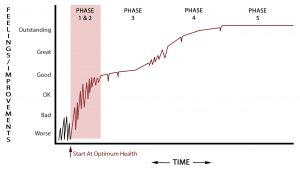 During phase 1, nutritional therapy is needed to fuel the DC process and the body’s reparative mechanisms. We perform a detailed nutritional assessment as part of the initial evaluation. The assessment results in a dietary and supplemental program designed to eliminate all nutritional deficiencies. We design the dosages of the supplements to mimic the intake of actual food. If the client needs beta carotene, for instance, they will be given the amount of beta carotene in a whole medium sweet potato. We will request that the client eat foods rich in beta carotene such as carrots and sweet potatoes.
During phase 1, nutritional therapy is needed to fuel the DC process and the body’s reparative mechanisms. We perform a detailed nutritional assessment as part of the initial evaluation. The assessment results in a dietary and supplemental program designed to eliminate all nutritional deficiencies. We design the dosages of the supplements to mimic the intake of actual food. If the client needs beta carotene, for instance, they will be given the amount of beta carotene in a whole medium sweet potato. We will request that the client eat foods rich in beta carotene such as carrots and sweet potatoes.
The body must have enough protein to prevent slow healing. Thus, the amount of protein recommended will mimic the amount in at least three whole eggs. The natural health practitioner will ask the client to also eat other foods rich in complete protein. This would be in line with the optimum daily allowance (ODA). The ODA is typically about ten times the recommended daily allowance (RDA). The RDA is the amount of nutrients that will prevent the display of symptoms of disease. It takes much more than that (i.e. the ODA) to supply the body with what it needs to repair and display vibrant health.
 Assessing the Toxic Heavy Metal Load
Assessing the Toxic Heavy Metal Load
During the first few minutes of the first DC, the dermal chelation specialist will look for black specks (BS) entering the detox water in ribbons. The specialist will also look for a BS film to develop on top of the detox water. If the BS film gets thick enough to block the view of the feet , the natural health practitioner performs a detailed assessment of the toxic heavy metal load. As a result, we test a 10 ounce sample of the detox water for mercury. Also, Trace Elements lab will analyze a sample of the client’s freshly-washed hair. The results of these tests will be used to develop and adjust the client’s chelation schedule and nutritional program.
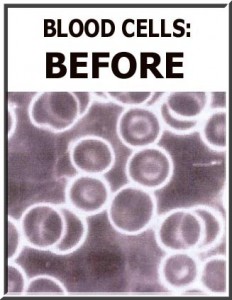
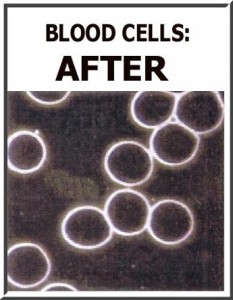 Typically, the blood and blood cells tend to remain fairly clean after each DC. ([1]) The body will keep reintroducing toxins into the blood if you do not eliminate the source. Typically during phase 1, the liver and kidneys get relief from removing toxins from the blood. As a result, these organs can focus on other processes. Is is important to do the dermal chelations according to a set schedule. Our specialist determine the schedule by the client’s level of toxicity and displayed symptoms at the initial evaluation. Each person must follow the schedule completely to synchronize the body to with the schedule. We will make modification to the schedule if there are consistent headaches or elevated blood pressures.
Typically, the blood and blood cells tend to remain fairly clean after each DC. ([1]) The body will keep reintroducing toxins into the blood if you do not eliminate the source. Typically during phase 1, the liver and kidneys get relief from removing toxins from the blood. As a result, these organs can focus on other processes. Is is important to do the dermal chelations according to a set schedule. Our specialist determine the schedule by the client’s level of toxicity and displayed symptoms at the initial evaluation. Each person must follow the schedule completely to synchronize the body to with the schedule. We will make modification to the schedule if there are consistent headaches or elevated blood pressures.
How Do Clients Feel During Phase 1?
Typically, clients feel lighter and more energetic during phase 1. Why? Because of the nutritional therapy, cleaner blood and organs returning to a less stressed state. Clients feel as if ankle weights have been removed from their legs after the removal of the heavy metals. Typically, the client’s eye’s will begin to have a healthy glow. Their coloring will improve and their posture will become more erect. Their perceived improvement may be because they actually begin to feel good right away. Or it may be because they feel twice as good as they normally do though they are still in the “feel worse” and “feel bad” categories as seen in graph 1.
Dermal Chelation: Phase 2
 Phase 2 begins at some time during weeks 2 to 4. At this point, the body realizes that the concentration of toxins in the blood keeps decreasing and possibly remains low. This will cause the body to leave toxin storage mode. It then starts taking toxins from the higher concentrations in the organ tissues, fat cells and bone marrow and releasing them into the blood. This is referred to as toxin dumping mode. Toxin dumping mode begins with what appears to be an arbitrary release of toxins into the bloodstream. However, it is an attempt to synchronize with the DC schedule.
Phase 2 begins at some time during weeks 2 to 4. At this point, the body realizes that the concentration of toxins in the blood keeps decreasing and possibly remains low. This will cause the body to leave toxin storage mode. It then starts taking toxins from the higher concentrations in the organ tissues, fat cells and bone marrow and releasing them into the blood. This is referred to as toxin dumping mode. Toxin dumping mode begins with what appears to be an arbitrary release of toxins into the bloodstream. However, it is an attempt to synchronize with the DC schedule.
Hierarchy of the Release of Toxins
The toxins are released according to a set hierarchy. The hierarchy is based on the level of perceived toxicity of the substances in the body. It is also based and the current state of damage of organ tissues. For instance, mercury is always focused on being removed before lead and cadmium. Mercury is perceived to be a more immediate threat to the body than lead and cadmium.
Consider a case study starting in 2009 just two years after we began developing this process. Mr. Matthews, a 42-year-old Caucasian male had been a welder and mechanic since age 7. He was very sick and no longer able to perform most of his duties. He would sit in his chair for hours too tired to get up. For two years he did dermal chelations three times a week. These dermal chelations focused on removing mostly mercury. During this time, his serial hair tissue mineral analysis (HTMA) showed lead below 0.1 µg/g (nl 0-0.3). A provocative urinalysis indicated the presence of lead (8.7 [nl 0-2.]). After two years of focusing on mercury, his body finally began to focus on the lead. Working with thousands of cases since 2009 has shown this to be the general hierarchy that the body prefers.
Synchronization with the Dermal Chelation Equipment
The amount that the equipment can assist with removing is not yet known to the body in phase 2. Therefore, toxins may be released in any amount according to the body’s toxic load. Prior to full synchronization with the DC quantity and schedule for removal, the blood may become toxic again. This can cause the person to have acute symptoms due to the release of toxins into the blood. These symptoms/findings, shown in table 1, are characteristic of phase 2 and can be more severe than what the client was experiencing prior to starting the DC process. It is typical for the dermal chelation specialist to note mostly severe releases of the substances monitored during this phase (ratings on a mild-moderate-severe scale). As a result, this phase is unstable creating a need for close monitoring.
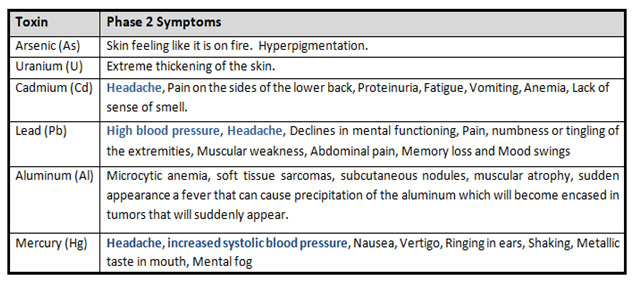
We have found mercury to be the main toxin that will increase the systolic blood pressure. Some research supports our finding that mercury increases the blood pressure. In 732 Inuit adults, blood mercury concentrations were associated with increased SBP. ([2]) HTMA has shown a direct correlation with mercury and systolic blood pressure as seen in graph 4 below.
 Scatter plot of systolic blood pressure (adjusted for covariates: age, sex, BMI, smoking and community) in relation to mercury exposure; regression line and 95% confidence interval (dotted lines). ([3])
Scatter plot of systolic blood pressure (adjusted for covariates: age, sex, BMI, smoking and community) in relation to mercury exposure; regression line and 95% confidence interval (dotted lines). ([3])
The more toxins the body releases into the blood during phase 2, the more noticeable the symptoms. Clients releasing severe levels of very harmful toxins like Hg, Pb, Cd and Ur will need to be monitored very closely by both the health practitioner and the dermal chelation specialist. It is important to monitor headaches and systolic blood pressures. These two symptoms can indicate a need for immediate adjustments in the dermal chelation schedule.
Dermal Chelation: Phase 3
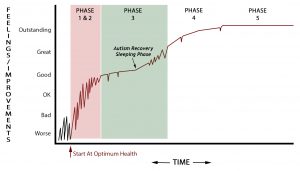 Phase 3 begins when the body has synchronized with the DC schedule and releases toxins into the blood stream only during the scheduled DC sessions. At this point, the body releases what appears to be a set amount of toxins each time. The amount released is based on the amount that needs to be removed from the body and the amount the equipment is capable of removing in a session. During phase 3, clients have reported feeling their legs swelling and tingling as they walk up to the entrance of our center. There are typically no negative symptoms or issues during this phase as long as clients do not skip their DC sessions.
Phase 3 begins when the body has synchronized with the DC schedule and releases toxins into the blood stream only during the scheduled DC sessions. At this point, the body releases what appears to be a set amount of toxins each time. The amount released is based on the amount that needs to be removed from the body and the amount the equipment is capable of removing in a session. During phase 3, clients have reported feeling their legs swelling and tingling as they walk up to the entrance of our center. There are typically no negative symptoms or issues during this phase as long as clients do not skip their DC sessions.
The Focus of Phase 3
During phase 3, it seems that the body no longer focuses on cleaning the blood. Instead, it appears to focus on scheduling the release of a set amount of toxins into the blood. Then the body can focus on releasing those toxins from the body. These toxins are released even if the DC process is not performed. We call this toxin dumping mode. As phase 3 progresses, the detox water begins to lighten indicating that less and less toxins are being released. We theorize that the brain’s level of toxicity decreases at this point allowing stem cells to be able to survive its environment. In the case of autistic individuals, the brain can begin healing. At this point, the autistic individual begins to sleep excessively. Therefore, we call this the autism recovery sleeping phase.
Phase 3: Skipping DC Sessions While in Toxin Dumping Mode
Once entering toxin dumping mode, you cannot skipping DC session. Why? Because your body can release large amounts of toxins at the scheduled time for a DC session. Skipping the DC sessions will cause these toxins to remain in the blood stream until the next schedule DC session. If the toxins released into the blood are highly toxic, the client will return to experiencing acute symptoms. The symptoms experienced will depend on the amount and type of toxin released as seen in the Phase 2 Symptoms table above. A person can experience minor symptoms such as feeling tired and sluggish as energy is diverted from the extremities to the management of the toxins. Or, a person might experience more severe symptoms such as feeling so sick that the person will, once again, be bed ridden.
Dealing with Toxins From Skipped Dermal Chelations
Since the body is no longer in toxin storage mode, the toxins from the skipped chelation will still be present in the blood when it is time for the next chelation. The body will release its normal amount to release. This can cause twice as many toxins to be present for removal. If the DC equipment is already removing the maximum amount possible, it will be unable to remove extra toxins presented for removal. This will cause the blood to remain toxic.
The body will begin releasing fewer toxins in order to allow the removal of those remaining in the blood. Eventually, removing the toxins from the blood will allow the blood to remain clean between chelations again. It typically takes 6-8 weeks for this process to occur. During this time period, the skipped chelations can cause large amounts of extremely harmful toxins to be present in the blood. Having these toxins in the blood for many weeks can cause organs such as the liver, heart, kidneys and brain to have major issues. These issues can be worse than the original issues before the dermal chelations were started.
As phase 3 continues, the toxic heavy metal load decreases causing the body to release fewer toxins with each DC. Moderate and sometimes only mild releases of the metal may occur during this phase. At this point, it may be recommended to begin decreasing the frequency or duration of the DC schedule.
Dermal Chelation: Phase 4
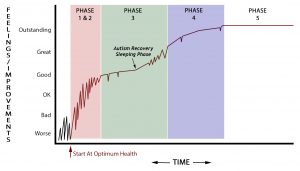 By the time phase 4 is entered, most of the stored toxins have been depleted and the body is no longer releasing the maximum amount that the equipment can remove. Therefore, skipping appointments, while not recommended, can happen without major consequences. Since there will be very little released into the blood, acute symptoms tend not to occur. Each DC session tend to release since smaller amounts of toxins. So, the subsequent session is able to remove everything released into the blood from the skipped session plus the current session. As the phase progresses, the client’s intermittent symptoms will eventually fade even if DC sessions are missed.
By the time phase 4 is entered, most of the stored toxins have been depleted and the body is no longer releasing the maximum amount that the equipment can remove. Therefore, skipping appointments, while not recommended, can happen without major consequences. Since there will be very little released into the blood, acute symptoms tend not to occur. Each DC session tend to release since smaller amounts of toxins. So, the subsequent session is able to remove everything released into the blood from the skipped session plus the current session. As the phase progresses, the client’s intermittent symptoms will eventually fade even if DC sessions are missed.
A person is normally able to stop the DC process at any time during phase 4 without any serious consequences. The worst case scenario would involve experiencing fatigue for a few weeks until the body realizes that it needs to return to toxin storage mode.
Dermal Chelation: Phase 5
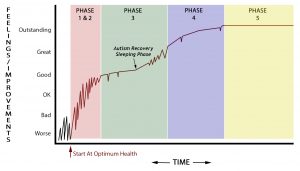
The goal of phase 5 is to have a maintenance program of one DC every four or more weeks. Continuing the DC process is optional at this point. The body will release what it deems necessary each time. If a person suddenly stops the dermal chelations during this phase, the worse we have seen happen is minor fatigue.
[1] Aqua Detox. Scientific Research, The Evidence. 2008;8
[2] Valera B, Dewailly E, Poirier P. Environmental mercury exposure and blood pressure among Nunavik Inuit adults. Hypertension. 2009;54:981–986.
[3] Fillion M, Mergler D, Sousa Passos CJ, et al. A preliminary study of mercury exposure and blood pressure in the Brazilian Amazon. Environ Health. 2006;5:29–46.
